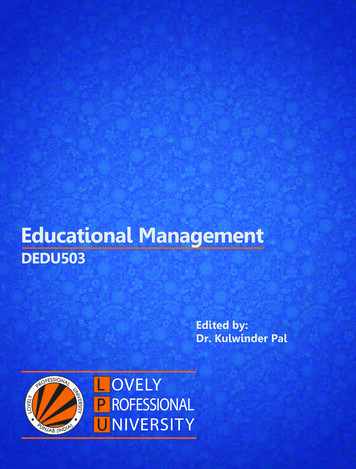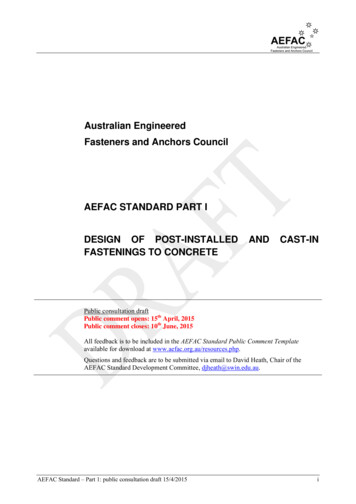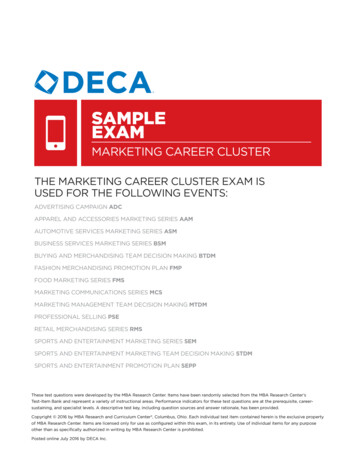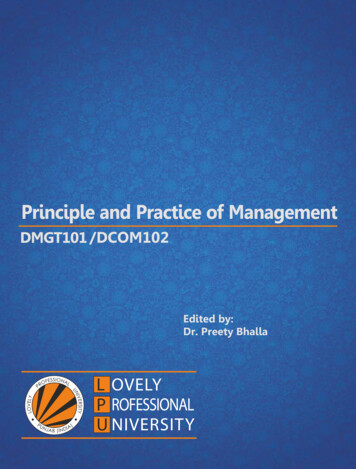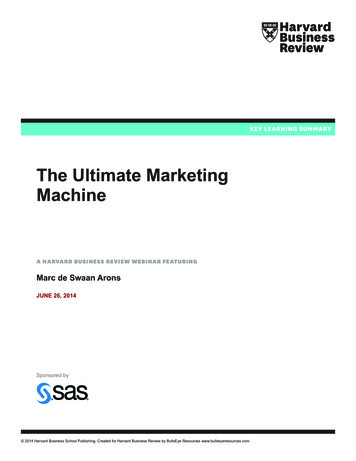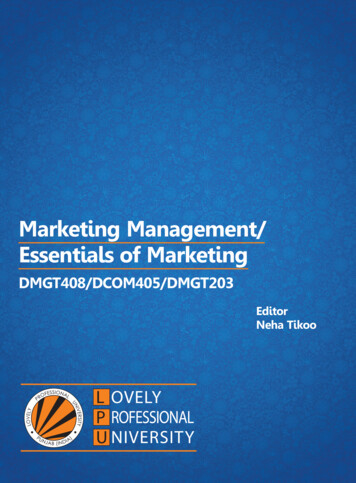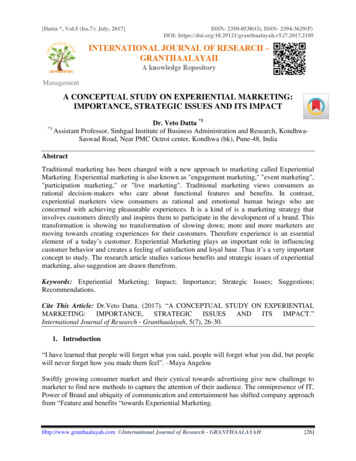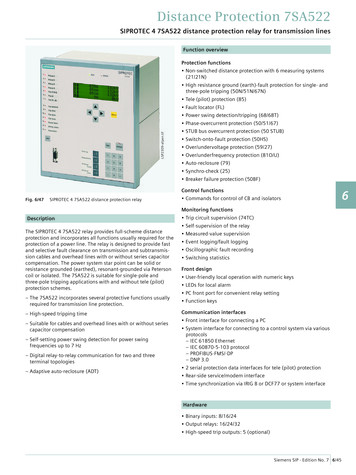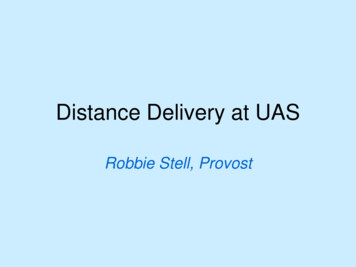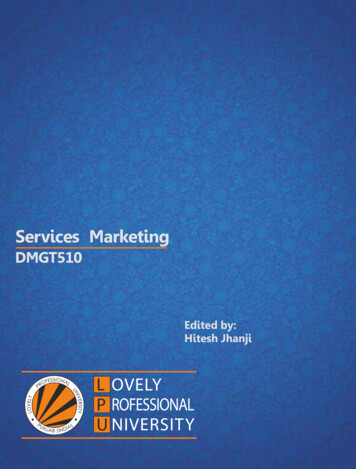
Transcription
Services MarketingDMGT510Edited by:Hitesh Jhanji
SERVICES MARKETINGEdited ByHitesh Jhanji
Printed b yEXCEL BOOKS PRIVATE LIMITEDA-45, Naraina, Phase-I,New Delhi-110028forLovely Professional UniversityPhagwara
SYLLABUSServices MarketingObjectives: The objective of this course is to acquaint the students to the uniqueness of the services characteristics and itsmarketing implications. The intent of the course is to discuss, measure and analyze several facets in the area of servicesmarketing essential for the success of a service sector firm.Sr. No.Discription1.Introduction to Services Marketing, Understanding Service Characteristics, Product versus Services,Classification of Services, Services Marketing Environment.2.7Ps of Services Marketing Mix, Purchase Process for services.3.Customer Expectations and Perceptions of Services through Marketing Research, CRM in services.4.Service Quality issues and Models on Service Quality.5.The Service Segmentation, Targeting, Positioning a Service in the marketplace, Understanding PositioningMaps, Developing Service Blueprint.6.Service Product & Operation, Understanding Employees and Customers Role in Service Delivery7.Pricing of Services, Delivering Service through Intermediaries, distribution growth options,Internationalization in distribution8.Developing Integrated Communication Program, Designing Servicescapes9.Competitive Marketing Strategy, Developing Service Recovery Strategies, Managing Demand, Supply andProductivity, Managing waiting Lines,
CONTENTUnit 1:Introduction to Services Marketing1Tanima Dutta, Lovely Professional UniversityUnit 2:Service Marketing Environment20Tanima Dutta, Lovely Professional UniversityUnit 3:The Service Marketing Mix and Purchase Process37Tanima Dutta, Lovely Professional UniversityUnit 4:Customer Expectations and Perceptions of Services through Marketing Research56Tanima Dutta, Lovely Professional UniversityUnit 5:Customer Relationship Management in Services80Sukhpreet Kaur, Lovely Professional UniversityUnit 6:Service Quality99Pretty Bhalla, Lovely Professional UniversityUnit 7:Service Segmentation and Targeting120Pretty Bhalla, Lovely Professional UniversityUnit 8:Market Positioning and Blueprinting in Services138Pretty Bhalla, Lovely Professional UniversityUnit 9:Service Product and Operation154Gopika Juneja, Lovely Professional UniversityUnit 10: Role of Employees and Customers in Service Delivery182Gopika Juneja, Lovely Professional UniversityUnit 11: Pricing of Services196Gopika Juneja, Lovely Professional UniversityUnit 12: Distribution of Services214Gopika Juneja, Lovely Professional UniversityUnit 13: Promotions and Servicescapes in Services234Hitesh Jhanji, Lovely Professional UniversityUnit 14: Service StrategiesHitesh Jhanji, Lovely Professional University256
Tanima Dutta, Lovely Professional UniversityUnit 1: Introduction to Services MarketingUnit 1: Introduction to Services ining Services1.2Understanding Service Characteristics1.2.1 More Intangible than Tangible1.2.2 Simultaneous Production and Consumption1.2.3 Less Standardised and Uniform1.2.4 Perishability1.3Product vs. Services1.4Classification of Services1.5Summary1.6Keywords1.7Review Questions1.8Further ReadingsObjectivesAfter studying this unit, you will be able to: Describe the concept of services marketing Define services Discuss the service characteristics Distinguish between products and services Classify servicesIntroductionAs India moves increasingly toward a services economy, marketers need to know more aboutmarketing service products. On a simplistic note, one can say that services are activities orbenefits that one party can offer to another that are essentially intangible and do not result in theownership of anything. Thus we see how services are different from goods.During the past decade services have increasingly assumed an important role in the Indianeconomy. Ever since this trend was set in the nineties, services have gained dominance. Thecompetition, simultaneously, in service organisations, is becoming intense and severe. As aresult these organisations have to have a more professional approach to managing theirbusinesses. Perhaps it is in this context that the role of marketing is gaining importance inservice organisations. In this unit, you will be introduced to the concept of services.LOVELY PROFESSIONAL UNIVERSITY1
Services MarketingNotes1.1 Defining ServicesOne of the first to define services was the American Marketing Association, which, as early as in1960, defined services as “activities, benefits, or satisfactions which are offered for sale, orprovided in connection with the sale of goods.” This definition took a very limited view onservices as it proposed that services are offered only in connection with the sale of goods.The other definition which was proposed, in 1963, by Regan suggested that “services representeither intangibles yielding satisfaction directly (transportation, housing), or intangibles yieldingsatisfaction jointly when purchased either with commodities or other services (credit, delivery)”.For the first time services were considered as pure intangibles capable of providing satisfactionto the customer which could be marketed like tangible products.Robert Judd defined service as “a market transaction by an enterprise or entrepreneur where theobject of the market transaction is other than the transfer of ownership of a tangible commodity”.Lehtinen, in 1983, defined services as “an activity or a series of activities which take place ininteractions with a contact person or a physical machine and which provides consumersatisfaction.”Kotler and Bloom, in 1984, defined services as “any activity or benefit that one party can offer toanother that is essentially intangible and does not result in the ownership of anything. Itsproduction may or may not be tied to a physical product.”Gummesson highlighting the intangible nature of services defined “services as something whichcan be bought and sold but which you cannot drop on your foot.” This definition also pointedout one basic characteristic that the services can be exchanged even though they are not tangible.According to Gronross, “a service is an activity or series of activities of more or less intangiblenature that normally, not necessarily, take place in interactions between the customer andservice employees and/or physical resources or goods and/or system of the service provider,which are provided as solution to customer problems.” CaseletMyths about Service Industrieshere are certain myths about services sector. It is because of these myths that peopleare unable to relate the role and contribution of the services sector in the economy.TThe first myth is that a service economy produces services at the expense of other sectors.The fact is that many service industries are major purchasers of manufactured goods. Takethe example of airlines, fast food outlets, educational institutions, etc., which buy so muchof manufactured products.The second myth is that service production is primarily labour intensive. In fact, a numberof service sectors like healthcare, hospitality, etc., are capital intensive. Productivity aretherefore equally important in service organisations as returns on capital employed willbe one of the major determinants of success.The third myth about services is that people satisfy their product needs before the need forservices. This is also not true. Research findings of a study revealed that people valueservices as much as products; however, they may buy services in a less cyclical way, ascompared to goods.Contd.2LOVELY PROFESSIONAL UNIVERSITY
Unit 1: Introduction to Services MarketingThe fourth myth about the services sector is that service businesses are ‘cottage industries’and service jobs are low paying. If you check the list of Fortune 500 companies you will besurprised to see the number of service companies figuring in this list.NotesThe other myth about the service sector is that services are only offered by the governmentsector. The fact is that on the one hand public services, like telephones, health care, powergeneration and distribution, etc., are being privatised and on the other hand large enterprisesare entering into services sector. Take the example of Escorts into health care, Tatas inpower distribution, etc. In fact the service organisations are quite varied and differentfrom each other.First category includes the public agency sector for example post offices, police and firedepartments, water and electricity authorities, etc. The second group is made up of theprivate non-profit sector running charities, foundations, old age homes or various societiesinvolved in issues related to women, literacy, family welfare, etc. Next comes the businesssector comprising banks, hotels, airlines, travel agencies, tour operators, courier services,insurance, consultancy – legal management or medical. Lastly, it is the sector which providesservices to those involved in manufacturing. This includes those firms providing securitypersonnel, accountants and auditors, computer operators and software consultants whichhelp manufacturing firms in their operations.In addition, there are a number of other types of services which are emerging in thewestern society. These range from, on a charge, the availability of a baby sitter to a groupof hippies making the party colourful. In India also such services are emerging whetherthey are a troupe of young boys and girls doing a music-cum-dance show on a birthday orwedding, house maintenance services, real estate brokers, security, etc.This definition takes into account the following important features of services: Services are by and large “activities” or they are series of activities rather than things. As a result services are intangible. They take place in the interaction between the customer and the service provider, whichmeans that services are produced and consumed simultaneously. Customer has a role to play in the production process as the services are provided inresponse to the problems of customers as solution.Self AssessmentState whether the following statements are true or false:1.Services are offered only as complementary or in a package with sale of goods.2.Services can be both tangible and intangible.3.Customers play an important role in delivery of services.1.2 Understanding Service CharacteristicsAs our knowledge of the characteristics of services grows, so does our ability to deal with themfrom both an economic and marketing perspective. Services are intangible, inseparable, variable,and perishable. Each characteristic poses problems and requires strategies to deal with thoseproblems.LOVELY PROFESSIONAL UNIVERSITY3
Services MarketingNotesFigure 1.1: Service CharacteristicsSource: Intangibility means that unlike goods, services can’t be seen, touched and felt, tasted or smelledor even heard before they are purchased.Inseparability suggests that services are produced, distributed, and consumed simultaneously.In the case of manufactured goods, production takes place in the production unit; thereafter thegoods are kept in inventory and transported to the distribution outlet from where the consumerspick them up for consumption.Heterogeneity means that services delivered generally vary in quality, time consumed in delivery,and the extent of service provided. Since people deliver most services, they are variable.Perishibility means that services can’t be stored.Example: For Airlines, in a particular flight, vacant seats remain unsold, whereas in thecase of manufactured goods, unsold items can be put into inventory and can be sold the next day.Marketers have to find ways to ‘tangibalise’ the ‘intangible’ to increase the productivity ofproviders who are inseparable from the product; to standardise the quality in the face ofvariability; and to influence demand movements and supply capacities better in the face ofservice perishibility.Services are relatively intangible, produced and consumed simultaneously and often lessstandardised than goods. These unique characteristics of services have specific marketingimplications and accordingly service marketer must adopt appropriate marketing strategies.Although service industries are quite heterogeneous (ranging from beauty salons to utilities),Berry identified some significant characteristics of services, which are shown in the followingtable:4LOVELY PROFESSIONAL UNIVERSITY
Unit 1: Introduction to Services MarketingTable 1.1: Characteristics of ServicesServiceCharacteristicsMarketing ImplicationsIntangibilityCannot be storedTangible cluesNo patentsPersonal sourcesNo ready displayWOMCommunication problemOrganisational imagePricing difficultiesCost accounting for pricesNotesStrategiesPost purchase mer involved inproductionSelection and training of contactpersonNo mass productionManage consumerSupply demand matchMulti-site locationStandardisation difficultIndustrialiseQuality control difficultCustomiseNo inventorisationCope with fluctuating demandBetter match through process1.2.1 More Intangible than TangibleA good is an object, a device, a thing. A service is a deed, a performance, an effort. When a goodis purchased, something tangible is acquired; something that can be seen, touched, perhapssmelled or worn. When a service is purchased, there is generally nothing tangible to show for it.Services are consumed but not possessed, therefore the absence of tangible features means thatit is difficult for the seller to demonstrate or display services and for buyers to sample, test, ormake a thorough evaluation. To reduce uncertainty, buyers look for signs or evidence of servicequality. Therefore, the service provider’s task, according to Levitt, is to “manage the evidence”and to “tangibalise the intangible”. Shostack even summarised that most market offerings are acombination of tangible and intangible elements. It is whether the essence of what is beingbought is tangible or intangible that determines its classification as a good or a service.TaskMention any five services that have significant tangible elements attached tothem and five goods that have service element attached to them.1.2.2 Simultaneous Production and ConsumptionServices are typically produced and consumed at the same time. The relationship betweenproduction and consumption therefore dictates that production and marketing are highlyintegrated processes.Example: The telephone company produces telephone service while the telephone userconsumes it.LOVELY PROFESSIONAL UNIVERSITY5
Services MarketingNotesGenerally, goods are produced, then sold, and then consumed. Services, on the other hand, areusually sold first, then produced and consumed simultaneously.The service provider and the client are often physically present when consumption takes place.Sasser observed that the firm is unable to store or transport services that only direct distributionis possible, thereby potentially limiting the number of markets the firm can cover. Apart fromthe stress laid on ‘right place’ and ‘right time’ in case of distributing goods, there is additionalimportance given to the performance of service in the ‘right way’ as well.1.2.3 Less Standardised and UniformIt is argued that it is often impossible to assure consistency in the services provided by a selleror to standardise offerings among sellers of the same service, while it is possible to offerconsistency and uniformity of products. Levitt argues that such a distinction has limited valuebecause it is a production oriented approach as even an identical generic product will bedifferentiated when it is viewed as offered product for sale. Thus, while the core product may beuniform, the process will always be differentiated.Secondly, Levitt argues that owing to the industrialisation of services, their production can nolonger be viewed as being heterogeneous. Attempts have been made to improve productivityin the service sector by the introduction of technology. Uniformity can be achieved by substitutingequipment and machinery for labour. Hostage suggested that service firms could also reducevariability by training the service providers in appropriate responses to each customer situation.They can also monitor customer satisfaction through suggestion and compliant system so thatpoor service can be detected and corrected.1.2.4 PerishabilityKurtz and Boone observed that the utility of most services is short-lived; therefore they cannotbe produced ahead of time and stored for periods of peak demand. The perishability of servicesis not a problem when demand is steady because it is easy to staff for the services in advance.When there are wide fluctuations in demand there should be a highly flexible productionsystem or idle productive capacity.Sasser has described several strategies for producing a better match between demand and supplyin a service business. On the demand side, the firm can make use of differential pricing, cultivatingnon-peak demand and developing complementary services. On the supply side, for effectivematching with demand, the firm may hire part-time employees to serve peak demand; peaktime efficiency routines can be introduced, facilities for future expansion can be developed, andincreased consumer participation can be encouraged.Self AssessmentMatch the following sets:Set A6Set B4.Services cannot be storeda.Intangibility5.Services cannot be patentedb.Inseparability6.Difficulty in quality control of servicesc.Heterogeneity7.No mass production of servicesd.PerishabilityLOVELY PROFESSIONAL UNIVERSITY
Unit 1: Introduction to Services MarketingNotes1.3 Product vs. ServicesLevitt has suggested, “There are no such things as service industries. There are only serviceindustries whose service components are greater or less than those of other industries. Everybodyis in service.” The point that Levitt was trying to put across is that with almost every tangiblecore physical product, an intangible service component is associated. Therefore, everybody is inservice.Figure 1.2It was as early as 1977 when Ms G Lynn Shostack, the Vice- President of Citibank, suggested thatmarketing ‘entities’ are combinations of intangible and tangible elements that are distinct anddiscrete. If these absolute tangible and intangible elements are taken to the two ends of acontinuum, we can observe that all goods and services don’t fall at one place. There is a rangethat varies from absolute tangible goods like salt to an absolute intangible service like education.TaskPrepare a tangibility spectrum and product-service continuum including servicesother than those given in this section.Theodore Levitt proposed the other approach of distinction between various goods. Accordingto him, goods can be put into two categories, namely, search goods and experienced goods.Search goods are generally those goods which are packaged goods and the customer can see,evaluate and try them prior to purchase.Example: Car, shampoo, etc.Experience goods, on the other hand, are those which one can see or evaluate after purchase.Example: Holidays, teaching, etc.Some persons call search goods as tangible goods and the others as intangibles. There is a rangebetween the two extremes and there could be certain products falling in this range, as explainedin Figure 1.3.LOVELY PROFESSIONAL UNIVERSITY7
Services MarketingNotesFigure 1.3Philip Kotler has further expanded and clarified the point of view of Levitt and suggests fourcategories in which product-service relationship can be categorised.Table 1.2S. No.1.Physical geneous3.Production and distribution areseparated from consumptionProduction, distribution andconsumption are simultaneousprocesses4.A thingAn activity or process5.Core value produced in factoryCore value produced in buyer-sellerinteractions6.Customers do not participate inthe production processCustomers participate in the production7.Can be kept in stockCannot be kept in stock8.Transfer of ownershipNo transfer of ownershipFirst, it is the pure tangible good which is like a commodity where it’s rather difficult todistinguish between the goods supplied by two suppliers and these goods look identical. Thereis absolutely no service or intangibles associated with either of the goods.Second, it is the tangible good with accompanying service. In this case the offer consists of atangible good with service(s) associated with it. Here an effort is made to distinguish the productfrom competing products based on service.Example: Consider two brands of refrigerators – one with a five-year guarantee whilethe other with a seven-year guarantee; based on the guarantee the manufacturer is trying todifferentiate the product.Third, it is a major service with accompanying minor goods or service. In this case themanufacturer or supplier is primarily offering a service to the market and along with it minorgoods or services may or may not be associated.8LOVELY PROFESSIONAL UNIVERSITY
Unit 1: Introduction to Services MarketingNotesExample: An airline is primarily offering the passenger transportation service. Howeverairlines also offer food and entertainment on board.The primary item, in this case, still remains transportation and food, entertainment, etc., remainsecondary. Lastly, it is the pure service where the offer is only a service.Example: Telecommunication, psychotherapy, health club, etc.Self AssessmentFill in the blanks:8.Teaching is a . service.9.Bathing soap is a pure tangible .10.Clothes come under the category of . goods.11.Manicure and Pedicure are types of . goods.1.4 Classification of ServicesEver since marketing researchers started defining services, they also proposed their classification.The first one was proposed as early as 1964 and the last, as late as 1989. Summary of theseclassifications has been given in Tables 1.3.Table 1.3AuthorProposed ClassificationComment1. Rented goods services (right to own and use agood for a defined time period)2. Owned goods service (custom creation, repairor improvement of goods owned by thecustomer)3. Non-goods services (personal, experience or“experiential possession”)First two are (1964) fairly specificbut third category is very broad andignores services such as l(1974)1.2.3.4.5.No specific application to servicescould apply equally well to goods.Shostack*(1977)Sasser etal.*(1978)Proportion of physical goods and intangibleservices contained within each product “package”Offers opportunities for multiattribute modelling.Emphasisesthat there are few pure goods orpure services.Hill(1977)1. Services affecting persons vs. those affectinggoods2. Permanent vs. temporary effects of the service3. Reversibility vs. non-reversibility of theseeffects4. Physical effects vs. mental effects5. Individual vs. collective servicesEmphasises nature of servicebenefits and (in 5) variations in 4)Type of sellerType of buyerBuying motivesBuying practiceDegree of regulationContd.LOVELY PROFESSIONAL UNIVERSITY9
Services MarketingNotesThomas(1978)1. Primarily equipment baseda. automated (e.g., car wash)b. monitored by unskilled operators (e.g.,movie theatre)c. operated by skilled personnel (e.g., airline)Chase(1978)Primarily people-baseda. ‘unskilled labour (e.g., lawn care)b. skilled labour (e.g., repair work)c. professional staff (e.g., lawyers, dentists)Although operational rather thanmarketing in orientation, provides auseful way of understandingproduct attributes.Recognises that product variabilityis harder to control in high contactservices because customers exertmore influence on timing ofdemand and service features due totheir greater involvement in theservice process.Kotler(1980)Extent of customer contact required in servicedeliverya. high contact (e.g., health care, hotels,restaurants)b. low contact (e.g., postal service, wholesaling)Synthesisespreviouswork,recognises differences in purpose ofservice organisation.Lovelock(1980)1.2.3.4.5.Synthesises previous classificationand adds several new schemes.Proposes several categories withineach classification. Concludes thatdefining object served is mostfundamental classification scheme.Suggests that valuable assification schemes in a matrix.People based vs. equipment-basedExtent to which client’s presence necessaryMeets personal needs vs. business needsPublic vs. private, for-profit vs. non-profitBasic demand characteristics- object served (persons vs. property)- extent of demand/supply- discrete vs. continuous relationships betweencustomers and providers6. Service content and benefits- extent of physical goods content- extent of personal service content- single service vs. bundle of services- timing and duration of benefitsThese classifications not only demonstrate the diversity of services but also suggest how importantit is in a specific situation to carefully analyse the detailed nature of the service operation. Thegeneral characteristics of services remain unchanged irrespective of the nature of service businesswhere the customer is always a person or group of persons; the service is perceived more or lessintangibly, some kind of interaction between the customer and some parts of the productionsystem of the service provider–including personnel, technology, or both – always occurs, andsome kind of input from the customer is always required in the process.These classifications do not suggest that a specific service is so unique that the basic fundamentalsof managing services do not apply to them. However, they do lay emphasis on various aspectsof service operation, types of resources to be used and how to manage the process depending onthe nature of service and the interface with the customers.10LOVELY PROFESSIONAL UNIVERSITY
Unit 1: Introduction to Services MarketingNotes Case StudyLakme Beauty Salon* – Extending Into Service Brandhe Lakme Beauty Salon (LBS) was inspired by Lakme, the brand that has for 50 yearsnow led the way in truly understanding the Indian woman. It is the classic exampleof an exercise in extending a product brand to a service brand.1 It seems not to haveescaped the usual pangs of extensions, although it has clearly sought to exploit definitemarket opportunities. Lever had tasted success in its previous brand extension exercises:Rexona, Lux and Liril soaps to deodorants, with Rexona particularly performingexceptionally, capturing almost 70% of the organized market share (it has, by 2004, droppedto 50%). But this brand extension was different: the product offer (Lakme cosmetics and skincares) of the mother brand possessed more tangible features than the extended serviceoffer (LBS), which mostly promised experience.TSimone Tata, wife of the late Naval Tata, had promoted Lakme, a distinctive jewel fromthe House of Tatas. But as a perceived misfit to the new strategic blueprint for the groupdrawn by Ratan Tata, the Chairman of Tata Sons (the holding company), in the midnineties, the cosmetic major was sold off to the FMCG major Hindustan Lever Limited(HLL)2.HLL turned over a ‘new leaf’ in 2001 when it set up LBS under its beauty brand, Lakmé. Theidea was to offer a complete brand experience3. Three years later, LBS contribute 11 percent to the company’s turnover, but only one per cent of Lakmé product sales are throughLBS outlets. LBS have not been a major success, since its branded service was often asuneven as the local beauty parlour. But, can the effort be called a failure?Performance: Lakme Lever has 50 per cent share in cosmetics market and 22 per cent inskin care, aiming to have a larger pie of the 1,000 crore salon industries, which isgrowing at 20 per cent. With 150 salons, LBS would also enter relatively small towns,while adding new salons in metros like Delhi, Mumbai, Bangalore and Chennai.Lakme & Beauty Industry PerformanceThe Indian cosmetics industry is in a state of flux. Even as the premium segment is gettingcrowded, the rural market is turning out to be the stronghold of smaller, regional players.Although stiff competition has emerged for Lakme Lever within the 250-crore colourcosmetics market, it continues to lead. In the skincare market, estimated at 700 crore,Lakme’s market share averages 7-8 per cent. (2003). Lakme Lever, which saw a 32 per centgrowth in 2003-04, plans to concentrate on growing the salon business through its LBS,while consolidating its core business of colour cosmetics and skin care.1The name Lakme has a very romantic origin, partly credited to the French origin of Simone Tata. In the Twenties andthe Thirties there was a very well known cabaret dancer in Paris of Indian origin, called Lakme. Her real name wasLakshmi; the rest is inspiration.2The sell off by the Tatas as a redefinition of their business was preceded by other sell offs: Tata Oil Mills CompanyLimited (TOMCO) to HLL; the liquor division of Forbes, Forbes & Campbell to Vijay Mallya’s UB Group etc. SimoneTata used the corpus from the sell-off to start their retail venture through Tata Retail Enterprise (TRENT): the Westsidechain.3It was to be the beginning of a series of steps by the household goods major to step into services.Contd.LOVELY PROFESSIONAL UNIVERSITY11
Services MarketingNotesLakme’s other VenturesLakme has had a mixed bag of success whenever it made forays into areas other than itscore cosmetics and skin care segments:FragrancesLakme had two fragrance brands, Ivana and Shie, which they withdrew some years ago.The fragrances market in India is too fragmented and has always had a strong presence ofbrands smuggled into the country and brought in through the gre
Services Marketing Objectives: The objective of this course is to acquaint the students to the uniqueness of the services characteristics and its marketing implications. The intent of the course is to discuss, measure and analyze several facets in the area of services marketing essen

